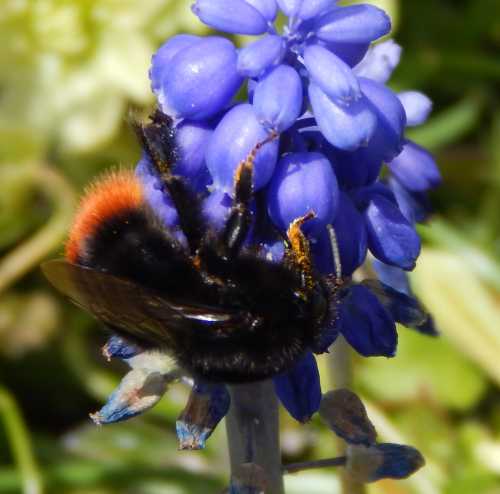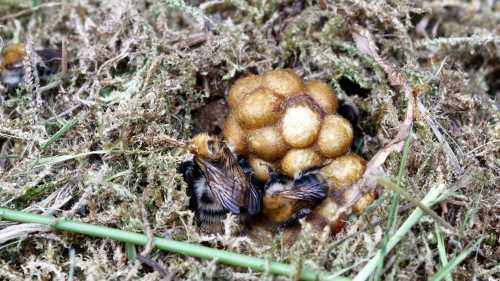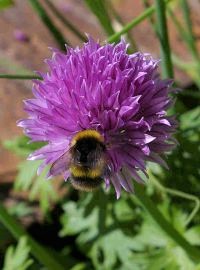The Bumble Bee Queen
Updated: 26th February 2021
All new bumble bee colonies start with a queen, who seeks out a suitable location for a nest. Once she has found just the right place, she begins making wax pots to house developing larvae, and for storing food for herself and her offspring.
Later, as new workers are reared and emerge from the nest, they help to grow the colony by providing food and carrying out other duties, such as cleaning and defending the colony.
In comparison with honey bee queens with a potential life span lasting several years, the queen bumble bee can live for up to 12 months (including overwintering time), yet it's still longer than the shorter lives of her worker and male offspring.
The Life Of The Bumble Bee Queen
The bumble bee queen will emerge from hibernation (sometimes referred to as diapause), already impregnated from the previous year, and she will then begin to feed.
Nectar will provide her with much needed energy, whilst pollen will give protein, and help her ovaries to develop.
 Red-tailed bumble bee queen, Bombus lapidarius
Red-tailed bumble bee queen, Bombus lapidarius
She will then begin the important task of finding a suitable
nest site.
You may see bumble bee queens early in the year, zig-zagging low across the grass, exploring banks and the base of hedgerows, as well as crevices in stone walls.
In gardens, an area beneath the garden shed may be explored, and you may witness bumble bees bumping into windows as they try to find just the right place to establish a nest and rear a colony.
Some species, prefer crevices, hollows, abandoned mouse holes, or even inside compost bins and empty bird boxes and houses. Others, notably the carders, make nests in the open on grassy turfs.
 Common carder bumble bee (Bombus pascuorum) nest
Common carder bumble bee (Bombus pascuorum) nestNest sites, due to habitat destruction, have become increasingly scarce, and queens will even fight over suitable sites.
However, once
an appropriate nest site has been found, the queen will then begin to
establish her colony. Seeing a queen bumble bee carrying pollen loads on
her legs is a signal that the establishment of a colony is now
underway.
How Is The Queen Different From Workers?
Here are 3 key ways in which the queen is different from her worker offspring:
- The queen bumble bee is larger than the workers (and
males) she produces.
- Unlike the female workers, she has the ability to
control the sex of the eggs she lays through the use of a chemical
signal (pheromone).
- Worker bumble bees can produce eggs, but whereas queens can produce males and females, worker offspring will be male bees only.
To learn more about this topic see: Do bees have X and Y chromosomes?
Cuckoos
Queens will sometimes face competition from cuckoo bumble bees. Cuckoos attempt to take over a nest, sometimes (but not always) killing the resident queen in the process.
Unlike the host, cuckoo species are unable to carry pollen or secrete wax to make cells.
A successful bumble bee colony
In truth, a colony can only be deemed successful if it has had the opportunity to produce queens that can mate and thus ensure future generations.
At the end of the season, only the newly emerged queen bumble bees will survive (although there are some exceptions in warm climates).
They will mate, and begin feeding to lay down fat reserves ready for their winter snooze.
These new queens will emerge to establish new colonies the following year.
Resources
- Osborne, J. L., Martin, A. P., Shortall, C. R., Todd, A. D., Goulson, D., Knight, M. E., Hale, R. J. and Sanderson, R. A. 2008. Quantifying and comparing bumblebee nest densities in gardens and countryside habitats. Journal of Applied Ecology. 45 (3), pp. 784-792. https://doi.org/10.1111/j.1365-2664.2007.01359.x
- Goulson, D. 2010. Bumblebees, Behavior and Ecology. Oxford Univ. Press, Oxford, U.K, Pp. 81.
- Benton, Ted. Bumblebees: The Natural History & Identification of the Species Found in Britain. Collins 2006.
Read more about bumble bees
- Is It Bumble Bee Or Bumblebee? Is It Written As One Word Or Two? Although both are used widely, here's an explanation as to why, according to the Entomological Society of America, it should be written as two words.
- The Bumble Bee Life Cycle - A Description, Photos And Video The bumble bee life cycle starts with an impregnated queen when she emerges from her nest from her winter snooze. She feeds and seeks a suitable place to nest.
- Bumble Bee Nests: Nesting Preferences Of Different Bumble Bees, and challenges in finding suitable locations for nesting.
- Bumble Bees All about bumble bees - their life cycles, pollination, and answers to common questions.
- Do Bumble Bees Make Honey? Bumble bees store nectar in little wax pots for feeding the colony as it grows, but it is not really quite the same thing as honey made by honey bees.
